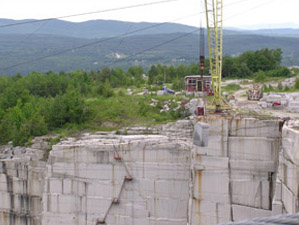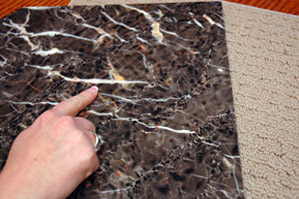Natural Stone | Before You Buy
Learn all you can before buying stone for your home. In this section we’ve laid down what we know and what you should consider before making your buying decision. Knowledge about stone specifics, characteristics, traits and subtle differences can be invaluable. Choosing the best stone for your home is really about knowing the right combination of characteristics, aesthetics, performance and budget to best meet the needs of your lifestyle.
- no two pieces are ever the same
- natural characteristics: color, veining and markings, hardness and porosity
- floor begins with giant pieces of stone that are mined from the earth
- transported to factories where they are cut into thin slabs
- each slab is different, displaying the affects of the physical course of its ancient history
- each tile cut from the same slab might look completely different from the next
- veining and crystallization may be abundant in one, yet non-existent in another
- variations are to be expected and enjoyed
- samples you view in the showroom can have completely different veining patterns or color variations compared to the stone we will install in your home
- is not possible for you to hand select each tile of your natural stone
- if you are concerned about the final appearance, work with a sales associate to preview a dye lot sample of the actual tile to be installed, prior to final installation
- irregular markings, lines, veins and crystallization are not cracks or imperfections
- if you select a combination of natural stone products, of the same color and type of stone, they will not match
- no natural stone tile will have a perfectly smooth surface
- may be small chips or pits that may be apparent in different lighting
- will vary more in thickness, squareness and length
- once installed, it will not be a perfectly smooth surface from tile to tile
- varies in hardness, which is the scratch resistance of a mineral
- talc is the softest mineral and diamond is the hardest
- consider what types of activities will be taking place where the stone is installed
- do not install a soft, porous type of stone in a high traffic area


Grout
- lines are typically filled depending on the stone tile itself
- can be thinner than ceramic tile installations
- can match, contrast or coordinate with your stone tile
- will outline each tile creating a visual picture frame
- to be less noticeable, select a grout that is close in color to the stone
- contrasting grout color, either darker or lighter, will make the grout lines more visible and thereby will create a checkerboard effect
- colors installed can be slightly different from the sample
- even when the same color is used, common to see slight differences between the grout in adjacent rooms
- exact layouts, type of grout and grout joint widths are determined by our tile setter at the time of installation and are governed by the actual size and shape of the tile, and the exact dimensions of the areas to be covered
Sealer
- highly recommended
- should be performed by professionals
- makes it less porous, more stain resistant, and protects the stone
- different types of sealer
- once flooring is installed, you are responsible for maintaining all caulked areas
Entire cost of ownership
The material “cost per square foot” of your stone flooring is just one component of the entire project cost. To ensure there are no surprises, and the stone you select fits within your overall project budget, be sure to ask us to calculate the total cost of your floor covering project. Here’s a list of potential additional expenses you may incur:
- furniture removal/replacement
- demolition/disposal of old floor covering
- sub-floor preparation
- product delivery
- stone installation
- materials required to complete the installation
In addition to the total project cost, you should also know the cost of annual cleanings to maintain the beauty and life of your new stone floor. Also, consult the manufacturer’s warranty and care guide for directions on how frequently the stone should be cleaned and the cost to clean it.

